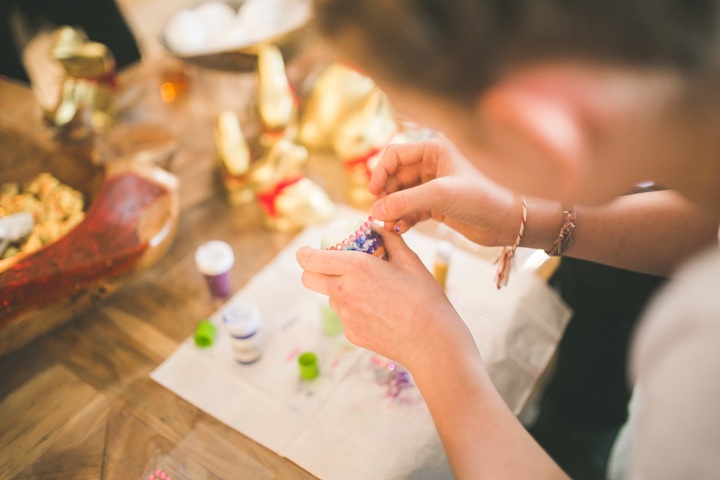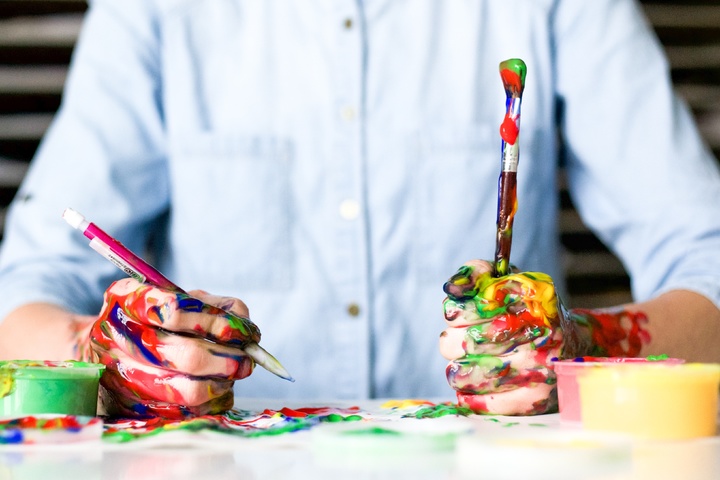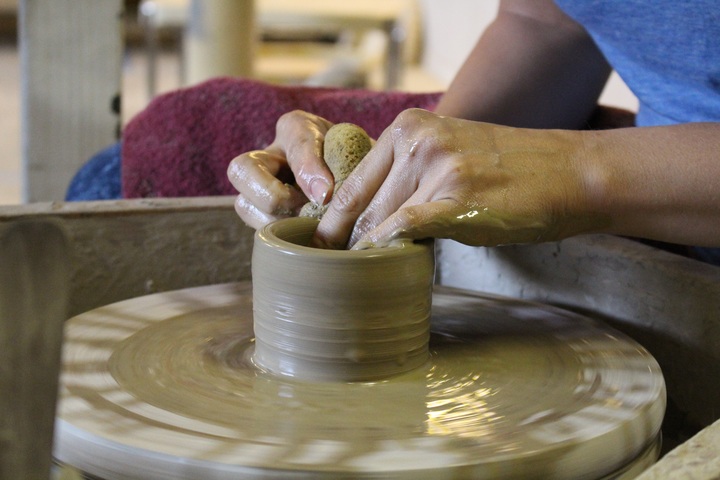Art therapy programs for seniors elevate the quality of care provided at any retirement or independent living facility.
Art therapy for seniors offers different health and social benefits for those coping with memory ailments or other cognitive disorders. According to Today’s Geriatric Medicine, in-depth neurological research confirms all assumptions that specialized art therapy programs (including painting, theater, music, pottery, dance, and poetry to name a few) do, in fact, improve the quality of life for retired seniors. Art therapy for seniors continues to increase in popularity among facilities situated in the elderly living industry. Now’s the time to update your services to better fit the everchanging needs of your elder residents!
There are many different ways to offer high-quality art therapy for seniors at your retirement care facilities. Dr. Raquel Stephenson of Lesley University explains the value of these unique artistic programs: “The power is in the art-making process—in how the artist engages with the art being made.” Medically speaking, “Making art can improve cognitive functions by producing both new neural pathways and thicker, stronger dendrites.” Seniors at your facility don’t need to be artistic geniuses or creative moguls to reap the benefits of these colorful, one-of-a-kind therapeutic activities.
A detail-oriented class like flower arranging or sketching is really a brain workout in disguise for those who are battling memory loss. A musical or play with weekly rehearsals helps fight off depression and feelings of loneliness in elders. The overall opportunity to take a step back and create something or feel imaginative for a bit helps relieve emotional and physical pain for a lot of seniors yearning to get their minds focused on something else, if only for just a moment.
As you likely already know, running a retirement or senior care facility is all about helping your residents find a new sense of purpose in their day-to-day life routines. Innovative programs like art therapy for seniors assist in filling this void for elders and help them feel this next phase in their life is a brand-new beginning and not an end by any means.
From arts and crafts to adaptive art projects and interactive programs, the many benefits of art therapy activities for seniors are endless. These specialized classes activate different parts of the brain for elders and produce physical as well as emotion improvements. Art therapy is quickly becoming a must-have on the checklist for those seeking quality care for their loved ones.
3 Amazing Benefits of Art Therapy for Seniors
1. Promotes Socialization and Making New Friends

Implementing art therapy for seniors at your assisted living facility is a great way to encourage elders to interact with one another, meet new people, and promote new friendships. The act of attending an oil painting art class pushes seniors to move outside their comfort zones and maintain a healthy level of daily human interaction; not to mention the awesome chance to meet others in similar phases of life, experiencing many of the same hurdles that accompany aging. While transitioning into a retirement home can be scary and stressful, art therapy for seniors can help. Why is this so important?
Here’s the deal. A recent study reported by TIME Magazine and conducted by the AARP foundation found about 24 percent of older individuals over the age of 70 are lonely. This statistic is due to many different life changes often taking place later in life and impact the day-to-day for elders. These naturally occurring life changes include losing close family members or friends, living alone, and spending more time inside. All of these elements contribute to the unfortunate loneliness factor common among retirees.
Luckily, sessions dedicated to art therapy for seniors help offset any common feelings of isolation among elderly individuals. Adjusting to life in a senior living home can be a struggle for many. Laid back, relaxing environments like jewelry crafting or summer candle making is an ideal, low-stress, and natural way for older people to get to know one another. Consider hosting art therapy for seniors as a mixer event for new residents to get to know each other—maybe even invite the families too!
Socialization and a strong core group of friends to rely on are key to feeling a sense of purpose as you age. Art therapy for seniors encourages healthy communication habits and positively impacts the quality of life for elders.
2. Improves Cognitive Skills and Memory Ability

Another amazing benefit of art therapy for seniors is a significant improvement in cognitive capabilities. Studies show these creatively innovative programs positively impact those elders coping with memory loss at all levels. According to the Fisher Center for Alzheimer’s Research Foundation, art classes push seniors with early-onset dementia to work their brains and really focus on one project for any given amount of time. These activities stimulate their brains as well as their memories.
For example, an effective way to tailor senior art therapy classes for those with cognitive issues might be to ask each participant in the class to sketch a drawing of any object from their past that symbolizes a significant moment in their lives. This active practice helps seniors exercise their brains while simultaneously working out their memory abilities too.
Living with Alzheimer’s or any type of moderate to severe memory loss is not easy. Many times, elders living with these ailments struggle with finding a sense of control and stillness in their everyday lives. The Fisher Center for Alzheimer’s Research Foundation explains how art therapy for seniors positively impacts their health and happiness despite health hurdles.
“Making art typically produces a sense of “flow,” or the ability to become immersed in the art-making process. The process can lead to an overall sense of purpose and well-being.”
Art therapy for seniors might not be the cure-all, but it’s evident these activities absolutely improve cognitive skills and memory ability as well. These creative programs allow your elder residents to feel more in control of their bodies and most importantly, their minds.
3. Reduces Physical and Emotional Pain

This last (but certainly not least) benefit of art therapy for seniors is where every single element really comes together. From daily moods to aging bodily soreness, adaptive art programs alleviate these pains.
From a physical standpoint, art therapy for seniors improves chronic pain symptoms like stiffness, joint pain, and swelling caused by common conditions like arthritis, fibromyalgia, and high blood pressure—ailments elders often deal with. Getting the body moving in a dance class, activating blood flow through the hand joints while clay making, or stretching before the big musical dance number all serve as healthy ways to reduce physical pain. These examples of art therapy for seniors emphasize body movement and benefit elders coping with muscle discomforts.
Emotionally, these classes often serve as something special throughout the week for seniors to look forward to. The sense of wanting to take part in something and create a piece of artwork bigger than just you are both big motivators that help fight off depression and decrease bad moods in elders. Additionally, art therapy for seniors has shown to successfully relax retirees and promote a sense of calmness in day-to-day life. No matter what the art or craft, the act of creating and innovating is therapeutic for human beings in general.
It’s helpful to note the Lippincott Nursing Center reports that “The American Art Therapy Association defines art therapy as a mental health profession in which clients, facilitated by the art therapist, use art and the creative process to explore emotional conflicts, foster self-awareness, manage behavior and addictions, develop social skills, and increase self-esteem.”
Art therapy for seniors provides a myriad of benefits for elders. Whether struggling with loneliness in this new phase of life as a retiree or fighting a daily battle with cognitive disorders at an assisted living facility, interactive art therapy programs spark creativity in elders while keeping their minds and memories activated.
Said best by the Population Health Learning Network, art therapy for seniors is a unique and effective form of counseling which “uses the creative process as an instrument for healing.”
Remember, sketching a detailed object exercises the brain and improves cognitive skills. Singing a solo in the holiday senior home play brings a sense of lightheartedness to life and adds humor to the everyday routine in a retirement home. Poetry club serves as a great way to meet others with similar writing and creative interests. Music class provides older people with the chance to learn something brand new about an instrument and brings a strong sense of purpose as elders embark on a new phase of life. Stringing jewelry or following a knitting pattern challenges seniors to practice attention to detail and focus, thereby improving awareness. And last but not least, creating a collage of fond memories from the best times of life successfully triggers positive memories and improves retention. When it comes to art therapy for seniors, the benefits and activity options are never-ending. The opportunities for growth and restorative care here are endless.
For more ideas, tips, and life advice to help you run your assisted living retirement facility with the highest level of care, manage trends in the senior care industry, and to better help your loved ones with the assisted living transition, visit our blog here.
Featured image and post images licensed for use via Pxhere.

